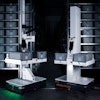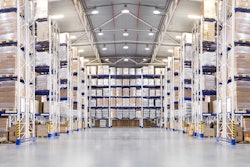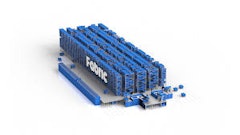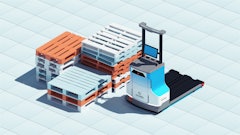
The retail industry is facing unprecedented pressure to enhance their e-commerce and omnichannel fulfillment, as consumers purchase through online channels more than ever. Worldwide e-commerce now accounts for more than 14% of all retail sales, and is predicted to reach 22% of retail sales by 2023.
The e-commerce boom demands not only faster order fulfillment and delivery, but also buy-online-and-pick-up-in-store (BOPIS or “click-and-collect”) capabilities — often with only a few hours from order to pick up. For grocers and big-box retailers, the emergence of BOPIS service level agreements (SLAs) can present significant disruptions to both their in-store operations and profit margins. Let’s explore the macro-level trends facing grocers and big-box retailers, as well as how a new approach to distribution using micro-fulfillment is poised to change the game.
Trends transforming the retail industry
Evolving customer demands in the retail landscape are disrupting the traditional brick-and-mortar model and driving retailers to identify new approaches to meet those demands. Here are a few of the key trends transforming the retail landscape:
• Demands for faster delivery. Customers are increasingly expecting next-day and even same-day delivery. Retailers need to improve last-mile and last-hour delivery methods to meet these needs.
• Increasing urbanization. A growing percentage of the world’s population lives in urban areas. Smaller distribution and fulfillment facilities close to these high-population centers can significantly improve last-mile (or last-hour) delivery. Brick-and-mortar retailers can also leverage existing stores for distribution and fulfillment.
• Competition for urban warehouse space. Opportunities for new facilities are limited, especially in urban areas. In these hypercompetitive markets, automation fulfillment solutions that can be deployed within smaller spaces offer ever-increasing advantages.
• Labor challenges. High turnover rates, staff shortages and calls for increased wages remain among the leading drivers for the acceleration of automated fulfillment processes.
• In-store fulfillment challenges. Fulfilling BOPIS orders has proven problematic and unprofitable for grocers and big-box retailers alike. Many are quickly realizing that using traditional in-store inventory for online order fulfillment is not a sustainable long-term strategy.
These trends and pressures have created a perfect storm of market conditions for micro-fulfillment center (MFC) strategies to emerge.
A new approach to distribution
Micro-fulfillment centers are ideally suited to address the unique challenges facing the retail sector by offering cost-efficient and flexible solutions to meet the changing demands of customers. Here’s why:
· Small physical footprint. MFCs typically occupy less than 20,000 square feet. Traditional distribution and fulfillment centers typically occupy 200,000 to 1 million square feet or more. The compact size allows MFCs the flexibility to be located within a small warehouse facility or integrated into an existing retail store.
· Distributed fulfillment agility. Utilizing MFCs can support a hub-and-spoke distribution model with a regional distribution center as the hub and multiple spokes located within proximity to densely populated areas. This model shortens the distance for last-mile or last-hour delivery, while supporting in-store pickup for retailers offering BOPIS fulfillment.
· Flexible automation solutions. MFCs can maintain an inventory of 8,000-15,000 SKUs with the automated efficiencies to enable accurate and high-velocity fulfillment. Depending on specific fulfillment requirements — such as speed, SKU counts and throughput targets — solutions can range from partially to completely automated scenarios, with proportionate investments in automation and robotics equipment.
MFCs often benefit from supplemental inventory from an attached store or a regional fulfillment center hub. In addition, they can help to reduce the cost of reverse logistics associated with returned goods by reducing return shipping costs. For some products, the time and costs for restocking returns can also be minimized.
Emerging technologies for MFC automation
Distribution and fulfillment technologies have rapidly progressed over the past decade. Equipment manufacturers are leveraging the following technological advancements to innovate new MFC solutions.
· AS/RS goods-to-person (GTP) shuttle. This solution utilizes proven automated storage retrieval system (AS/RS) shuttle systems, but on a much smaller scale. The shuttle retrieves goods from one or more aisles of high-velocity inventory — such as the dry goods shelves — and delivers items directly to an operator station for picking and order consolidation. The goal is to stock the majority of the SKUs in the MFC and allow the remainder of inventory to be picked off the store shelves or other nearby pick locations.
· Enhanced robotic integration. Advanced MFC systems seek to maximize fulfillment accuracy and productivity. Storage systems can be equipped with mobile robots in a goods-to-robot (GTR) configuration with the potential to integrate robotic arm and artificial intelligence (AI) technologies for picking.
In an advanced MFC system, AS/RS shuttles are still responsible for storage and retrieval, while mobile robots are integrated into the decanting, consolidation and picking processes. Mobile robotics have the capacity to support human employees by transporting goods from the workstations on the floor, while robotic arms perform picking at GTR workstations. These powerful robotic solutions are capable of processing high volumes of data for faster decision-making and offer the flexibility to adapt to a full spectrum of process workflows.
The future of retail with micro-fulfillment
Warehouse automation solution providers are combining robust automation equipment and robotics with advanced execution software to meet the demands for micro-fulfillment across the retail spectrum. As retailers brace for ever-increasing fulfillment and consumer demands, their abilities to meet expectations for next- and same-day delivery (or in-store pickup) will be essential to their survival. MFCs can be the key to meeting evolving consumer demands in this hypercompetitive marketplace.

















